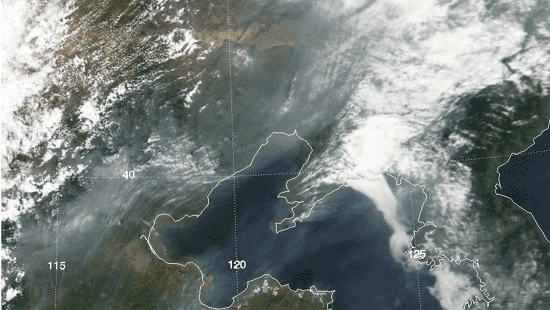On the Importance of Locality When Estimating the Aerosol Effects on Climate
It is well understood how the emission of greenhouse gasses (GHG) warms the atmosphere. Some of the key greenhouse molecules stay in the atmosphere hundreds of years (co2 lifetime is estimated to be 50-200 years) and are therefore well mixed in the atmosphere and absorb the thermal radiation uniformly around the globe. Aerosols, however, are suspended in the atmosphere between hours to weeks over a limited area, hence their effect will be concentrated on a regional scale. This should be considered when estimating the anthropogenic impacts on climate.
On the effect of anthropogenic aerosols
To answer how do manmade aerosols - solid or liquid particles suspended in the air - change climate, one must consider many atmospheric processes and feedbacks. Aerosols interact directly with solar radiation and indirectly by changing cloud properties. Clouds cover more than half of the globe at any given moment, reflecting part of the solar radiation back to space and absorbing part of the thermal radiation. The effect of clouds on Earth radiation depends on a cloud’s size, shape, height, lifetime, phase (water or ice) and droplets/ice particles size distribution. It is shown that all of these cloud properties are linked to aerosols and therefore, depend on aerosol type and loading.
Aerosols and clouds
Cloud aerosol interaction forms one of the major unknowns in the field of climate change. Even the general trend, warming or cooling, is not clear yet. In general, there are two types of opposing physical processes competing on the effect of aerosols on clouds. Aerosols from biomass burning or from incomplete combustion of burning fuel, as in automobiles or the industry, may contain components like black carbon that absorb part of the solar radiation. These aerosols are heated by the absorbed radiation and as a result warm their surroundings. The heated atmospheric layer reduces the relative humidity within it, stabilizes all the atmospheric layers below it, and thus, reduces the fluxes of moisture from the surface. Consequently, the likelihood for a new cloud formation and the livelihood of existing clouds is suppressed [1]. On the other hand, the aerosols serve as nuclei, or seeds, for condensation of cloud droplets. Therefore, more aerosols in the cloud will generate more and more droplets, smaller in size, while competing on the same amount of available water vapors. Smaller droplets are less likely to collide or to be collected by other droplets, hence less large rain drops will be produced. It was shown that clouds formed from smaller droplets will climb higher in the atmosphere, will live longer and their early precipitation will be suppressed [2]. Clouds with more droplets and longer lifetime will reflect more solar radiation back to space and hence, will cool the atmosphere.
In a recent study [3], a network of ground sensors (AERONET) was used to estimate simultaneously the effect of aerosol concentration and absorption on cloud cover. The opposing effects on clouds were observed: as total aerosols increase, cloud cover increases; and as radiation absorption by aerosols increases, cloud cover decreases. These effects were shown for all locations, for all seasons.

Figure 1. Heavy pollution and clouds over Beijing form MODIS July 20 2005 (http://modis-atmos.gsfc.nasa.gov). Aerosols may promote cloudiness in one place and suppress in other.
The scale mismatch
The typical scale used for estimation of climate change is global. We sum up the estimated contribution from the different effects into one global number defined as the global anthropogenic forcing on climate (in energy per time per area units) [4]. While this approach is right for greenhouse gases that are well mixed in the atmosphere, this may miss some of the key consequences of aerosol forcing. As the local-warming can be canceled out by the local-cooling effects and since the overall trend is cooling, the notion may appear to be that aerosols even help to cancel out the greenhouse gasses warming effect.
Although this may be right on the global scale, aerosols will warm the atmosphere in one location due to absorption, heating and cloud choking, while in another location, will cool the atmosphere through cloud microphysical process. The local forcing can be much higher than the global GHG forcing which will act for a relatively short time and on a limited area. Such forcing can be considered as a shock treatment to the atmosphere and is different in nature from the constant uniform GHG heating.
Local heating and cooling by aerosols may change synoptic patterns, and therefore change the magnitude and location of lows and highs, changing precipitation, temperature and humidity patterns. Clouds may persist over regions where they would normally precipitate and the likelihood and magnitude of severe weather events, such as tropical cyclones and severe thunderstorms, may be intensified. The local balance will be disturbed and as often happens in complicated systems, the deviation from balance may propagate to larger scales, eventually changing the global thermodynamic balance.
[1] Science 27 February 2004, Vol. 303, pp. 1342 - 1345
[2] Science 27 February 2004, Vol. 303, pp. 1337 - 1342
[3] Science, 4 August 2006, Vol. 313, pp. 655-658; published online 12 July 2006
[4] IPCC 2001, http://www.grida.no/climate/ipcc_tar/wg1/index.htm







 Read more
Read more